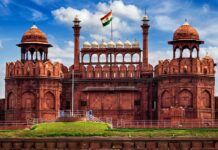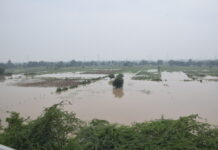[vc_row][vc_column][vc_column_text]
The dance of death that India witnessed during the disastrous covid-19 surge in April-May was quite traumatic with people scrambling for hospital beds, oxygen cylinders, ventilators, and medicine to save their loved ones. The ordeal of those who could not save their family members was no less cruel. While getting a space for last rites in itself was a challenge, arranging firewood for pyre was another harrowing experience in the wake of covid rush. However, as they say need is the mother of all inventions the North Delhi Municipal Corporation (NDMC) has found a way out of this problem, that too an eco-friendly one.
Such was the rush for funeral services that it had become a big challenge for the authorities to dispose of the bodies with shortage of firewood at crematoriums. In April alone, official tally of 38,719 covid deaths in country out of total 2,01,187 fatalities due to contagious corona virus is enough to assess the additional burden on the crematoriums which are meant to cater to on an average 28,000 daily deaths in India. The situation warranted rejig in the socio-cultural aspect of life to meet the challenges of contemporary times while keeping the faith in the rituals intact.
The huge demand for fuel to clear the rush of covid dead not only prompted aggressively promotion of electric crematoriums but also search for others alternatives. According to a data from the NDMC, one of the three civic bodies of the National Capital, 7,017 dead bodies of covid victims, both confirmed and suspected, were cremated during April-May 2021.
Dr Pramod Verma, municipal health officer (Public Health Department), said, “There was unprecedented rush of dead bodies for cremation in April in addition with the surge in covid cases in the city. So much so that it was a big challenge to arrange additional firewood which was high in demand. We had to struggle hard to procure adequate wood for the hundreds of the dead bodies lying in the crematorium for the last rites.”
Such was the gravity of the situation that the NDMC had no option but to meet the additional demand by cutting 14,034 trees to clear off bodies of covid dead for cremation besides 5,170 deaths occurred due to natural causes. According to the civic body, 400 kg wood was required for single cremation which is equal to two fully grown trees.
Going by the data on the additional wood used to clear covid rush at the crematorium in just one month i.e. April 2021, the number of trees cut down to cremate 38,719 covid dead (official figure) might have been around 77,438. If we extend this tally to the total number of covid deaths occurred till April 2021 i.e. 2,01,187, the number of trees which may have been chopped off for the cremation must have been around 40,2,374. This is in addition to the 56,000 daily demand of trees required to cremate 28,000 dead bodies on an average in India.
An alternative to firewood
In its bid to meet the additional demand for cremation, the NDMC experimented with fuel manufactured from cultivation refuse (agricultural remains called Parali) and cow-dung cakes/bricks/upla (goparali fuel) as a supplement to fuel wood. The Public Health Department prompted to take the initiative at the instance of the public representatives who were in favour of using cow-dung cakes.
“This (the cow-dung cake) if used as fuel, can cut down on the consumption of wood and thereby result in saving trees which in turn would reduce the load on environment. Use of Parali offers an incentive to farmers against burning of left-over straw, which becomes a major source of pollution in the National Capital, as they could make money by selling the stubble to the cremation ground,” elaborated Dr Verma.
Many NGOs roped in to create goparali are now insisting on replicating the experiment throughout the country as “this would have a major impact on efforts to protect the green cover”.
According to a 2018 report in CNN, 50-60 million trees are burnt for cremation every year in India. Manikarnika Ghat in Varanasi alone cremates around 100 bodies every day. This has been one of the major concerns of conservationists and environmentalist who have been pushing for alternatives for cremation for many years. Many experiments in this direction have been done in the past by changing the designs of crematoriums to facilitate metal-box and cow-dung pyres.
Shortage of firewood during covid-19 pandemic for cremation has further pushed the environmental concerns. It is high time wood was completely replaced with other materials for cremation. This is the need of the hour as the spectre of climate change is looming threatening to change the lives of millions adversely.
According to a study by Global Forest Watch, released by the World Resources Institute (WRI) in 2019, India has almost lost 16 lakh hectare of tree cover between the time period of 2001 and 2018. The report claimed that this is equivalent to almost four times the geographical area of Goa. Deforestation has a direct bearing on the global temperature andeven a slight change in weather pattern disturbs the flora and fauna of any region directly impacting the agriculture.
Another study published by the World Meteorological Organisation (WMO) says by 2025 there will be 40 per cent chance of at least one year being 1.5C hotter than the pre-industrial level.
A latest study by Germany’s Potsdam Institute for Climate Impact Research and The Tata Energy and Resources Institute (TERI) has drawn a scary picture for the beautiful mountainous State of Uttarakhand. It has revealed that Uttarakhand’s temperature would change as much as 1.90 by 2050.
These reports present a scary picture. The catastrophe of climate change is just there in front of us. Corona pandemic will eventually pass off, but it is also teaching us a very important lesson – how we cannot afford to be complacent, how it is important to stop and think where and how we can make a difference.
It is, therefore, time to shun this one big practice of using wood for cremation and move on to alternatives like electric crematoriums, iron pyres, using cow dung cakes, Goparali or anything else which could help us save as much as trees as we can.
Hindu samskara for cremation
According to Hindu belief, last sacrament in the life of a person is the funeral with which he closes the chapter of worldly life. Since both the birth and the death, in Hinduism, are led by samskara (a purificatory ceremony or rite marking a major event in one’s life) for transition to next world (after death), which according to the scriptures, is higher than that of the present one. The ritualists, therefore, are very anxious to have the funeral performed with meticulous care.
For those who are believer, and even for the non-believers, rituals of death and the last rites have meanings beyond just the emotions. According to Baudhyana Pitmedha-Sutra, “It is well known that through the Samskara, after the birth one conquers this earth, through the Samskara after death, the Heaven”. Hence, for many, any change in ritualism might be interference in their belief system but the pandemic has opened the realm of practical problem of availability of fire wood besides the threat to environment caused by blatant chopping of trees for cremation.
But more than the medium of cremation, the philosophy behind cremation is sacrosanct, which in itself supports the very theory of safeguarding the environment. Offering the dead to the ‘panchtatva’ is one of the basic philosophies of Hindu religion.
The panchtatva philosophy
Traditionally, as a common ancient practice, people who would attend the funeral used to carry some wood as a mark of respect to the dead person and also for contributing their part of wood for the cremation.
The philosophy goes that the human body is made up of five elements – earth, air, sky, water and fire – and it should be consumed by these very elements, releasing the soul from all earthly connection to set it off to its further journey. People thus contributed their bit through wood to let the body be consumed back to five elements and as a mark of respect for the soul in its journey ahead.
Thus, no tree was chopped for cremation and only the dead wood which every family had in their houses for their personal usage was contributed. The practice, however, faded over the time with changed circumstances, urbanisation and lifestyle change.
Therefore, changing certain practice would not change the belief, nor would it alter the faith but it would definitely change the way humanity would survive on earth. Also, it is in sync with the philosophy of cycle of life in Hinduism and we have a big role in maintaining this cycle.
[/vc_column_text][/vc_column][/vc_row]
Disclaimer: We do undertake rigorous checks on content provided by contributors before publishing the same. If you come across some factual errors, kindly bring this into our notice and we shall review your objection and claim as per our policy and display correction credits and corrections on the article itself.
The opinion expressed in the article is of the writer. Writer is a freelance journalist/journalist based in Delhi





























